Pipe Lining of an Accessible Oval Profile with Light-Curing Reaction Resin Systems in Bremen, Germany
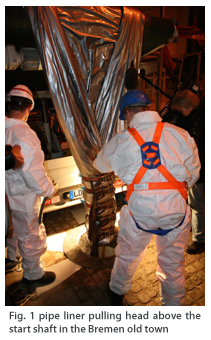 Sewer rehabilitation: The rehabilitation of sewage pipes using pipe lining with light-curing reaction resin systems penetrates into new dimensions of use. The pacesetter in the development of accessible diameters for this technology is up till now the Brandenburger liner system. Current example: With the connection of the Brandenburger liner and the BLUETEC lamp technology, which has been in use since 2006, an accessible oval profile sewer with a length of 173 m was lined with a 9.8-mm thick glass fiber liner in Bremen in the spring 2008. Among the decisive factors for the selection of this technology by the HanseWasser Bremen GmbH as client was the extremely tight schedule.
Sewer rehabilitation: The rehabilitation of sewage pipes using pipe lining with light-curing reaction resin systems penetrates into new dimensions of use. The pacesetter in the development of accessible diameters for this technology is up till now the Brandenburger liner system. Current example: With the connection of the Brandenburger liner and the BLUETEC lamp technology, which has been in use since 2006, an accessible oval profile sewer with a length of 173 m was lined with a 9.8-mm thick glass fiber liner in Bremen in the spring 2008. Among the decisive factors for the selection of this technology by the HanseWasser Bremen GmbH as client was the extremely tight schedule.
The procedure used in Bremen has already proved itself in 28 countries, in which more than 2,000 km of sewers have been installed in diameters from DN 150 to DN 1,000. In principle, the Brandenburger pipe liner procedure is based on the same basic idea as all other pipe lining systems: A tube support saturated with reactive synthetic resin is brought into the sewer, where it is expanded with inside pressure to be form-fitting, i.e. with no ring gap, and then cured by a chemical reaction of the resin to a self-supporting inner lining. This technology is consequently trenchless, as no type of earthworks are necessary. The flexible liner tubes are typically applied using existing inspection shafts in the sewer (fig.
1). The special characteristics that differentiate the Brandenburger liner system in its totality from other pipe lining types are:
- Use of seamlessly wound liners out of glass fiber laminate webs,
- Unique saturation of the raw materials before the production of the pipe liner with UV-reactive UP resin (possibly with addition of peroxides for the variation “hybrid curing” for larger wall thicknesses more than 10 mm),
- Drawing in the liner on a protective foil and form-fitting expansion using compressed air and
- Curing of the liner using precisely dosed UV exposure (BLUETEC technology).
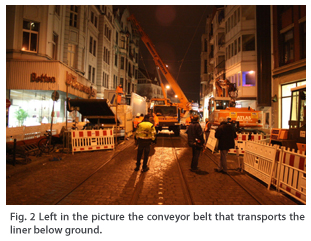 The key requirements for the specifications of a pipe liner material are stability, chemical resistance and longevity. Glass-fiber reinforced plastic (GFRP) fulfils these requirements exemplarily, also in many other areas of use. For this reason the liner system used in Bremen also took advantage of the virtues of this composite material, which is manufactured in the production facilities in Landau, Germany, with a specific technology. Webs out of glass fiber laminate are wound diagonally and overlapping on a rotating drum and removed as a tube. This technology produces seamless tubes with the same wall thickness at each point, identical wall construction and a large stretch behavior.
The key requirements for the specifications of a pipe liner material are stability, chemical resistance and longevity. Glass-fiber reinforced plastic (GFRP) fulfils these requirements exemplarily, also in many other areas of use. For this reason the liner system used in Bremen also took advantage of the virtues of this composite material, which is manufactured in the production facilities in Landau, Germany, with a specific technology. Webs out of glass fiber laminate are wound diagonally and overlapping on a rotating drum and removed as a tube. This technology produces seamless tubes with the same wall thickness at each point, identical wall construction and a large stretch behavior.
For production of the glass laminate only E-CR glass fibers from Advantex (in two variations, ADV 75 and ADV 120) are used, which exhibit the highest level of corrosion-resistance. Brandenburger pipe liners are currently produced in diameters of DN 150 to DN 1,000, with which not only corresponding circular profiles can be rehabilitated but also oval and special profiles, such as the Bremen oval profile 800/1,200, which corresponds to a DN 1,000 circular profile.
The Resin Systems:
For saturation of the liner two types of synthetic resin are optionally used:
- Polyester resin (UP) according to DIN 18820 Group 3, Type 1140 or according to DIN EN 13121 Group 4 and
- Vinyl ester resin (VE) according to DIN 18820 Group 5, Type 1310 or according to DIN EN 13121 Group 7A
While the polyester resin is used for standard municipal sewage water, the VE resin is a special, particularly resistant option for chemically or thermally aggressive sewage water. Both resin systems react to UV radiation with a wavelength between 360 and 420 nm with polymerization (bonding). The resin-impregnated liner in the sewer is exposed to the required radiation, until it is cured, by a lamp train that is centered in the sewer using adjustable spacers with wheels, which moves through the calibrated tube with uniform speed. The amount of radiation that lands on each point of the liner surface results from the light intensity and the speed of the radiation source (i.e. the exposure time) in the sewer. The amount of light that is required for curing results from the resin recipe and the wall thickness of the liner.
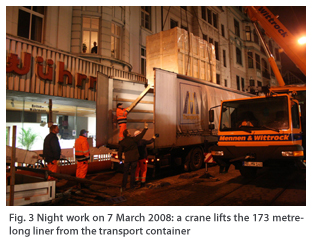 The required combination of the corresponding parameters for a reliable rehabilitation result, i.e. a continuously cured liner, is exactly defined for each diameter and each wall thickness. Using this data, the light curing process is regulated and controlled by the on-board computer of the vehicle. Each parameter is recorded and documented at each point in time of the curing. This makes it possible to follow the correct curing process live. If deviations from the target quality of the cured liner should occur, the recording makes it possible to subsequently find the causes.
The required combination of the corresponding parameters for a reliable rehabilitation result, i.e. a continuously cured liner, is exactly defined for each diameter and each wall thickness. Using this data, the light curing process is regulated and controlled by the on-board computer of the vehicle. Each parameter is recorded and documented at each point in time of the curing. This makes it possible to follow the correct curing process live. If deviations from the target quality of the cured liner should occur, the recording makes it possible to subsequently find the causes.
Even faster and more secure: The BLUETEC Technology: Important progress regarding secure process control of the curing procedure was the development and implementation of BLUETEC technology by Brandenburger in 2006. It is based on the new, even more powerful UV halide lamps and a new control technology. Nine light sources make a lamp train. With this technology each light source can be controlled steplessly from 400- to 1,000-watt radiation power. This does not hold for all light sources at the same time, but rather optionally for certain individual light sources in the lamp train. The result is extremely flexible use. On the one hand, all diameters can be cured with one and the same unit, therefore different modules are not needed for different dimensions. On the other hand, with the possibility of a separate switch of individual light sources, critical situations can be reacted to such as the unexpected failure of a light source during the process.
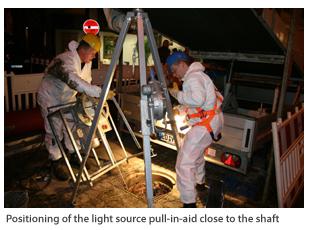 Light curing has important advantages compared to other pipe lining thermal hardening processes. The most important is surely the time factor. In small diameters speeds of 150 m per hour can be achieved. And the ability to completely cure a 173-m liner in an accessible oval profile within four and a half hours, as shown with the Bremer example, makes rehabilitation possible in very tight time frames. This is not just an economic advantage — it also makes it possible to restart normal drainage operation in the connection lines much more quickly.
Light curing has important advantages compared to other pipe lining thermal hardening processes. The most important is surely the time factor. In small diameters speeds of 150 m per hour can be achieved. And the ability to completely cure a 173-m liner in an accessible oval profile within four and a half hours, as shown with the Bremer example, makes rehabilitation possible in very tight time frames. This is not just an economic advantage — it also makes it possible to restart normal drainage operation in the connection lines much more quickly.
Option for Large Wall Thicknesses: Hybrid Curing: Liner wall thickness up to 10 mm for Brandenburger pipe liner can be cured without problem with UV light (for other light-curing pipe liners the limit is lower). Above that, for instance if larger wall thicknesses are required in oval profiles, pure light curing can become uneconomical due to the significantly slower drive-through speeds. Thus Brandenburger developed the combination or hybrid curing, which has been used since 2000. This is based on a modification of the resin recipe. Thermal reactive peroxides are mixed into the light-curing resin. Now the UV light curing leads to a secondary chemical reaction due to the reaction temperature of the resin. This triggers the thermal curing. If the UV light has warmed the liner to approximately 60 C due to the UV light curing, the peroxides “ignite” the thermal reaction. Both curing mechanisms lead to the final polymerization of the resin matrix. With the hybrid curing, GFRP liners with practically unlimited wall thickness can be installed without compromising the other advantages of the process, especially the speed.
 Light curing has an important logistic advantage: As pure light-curing resin does not react to heat, the light-curing pipe liners, protected by a styrene-proof light protective outer foil, can be stored with no practical limit. Purely thermally curing liner systems, however, must be manufactured and delivered more or less “just in time” and also be cooled, which can be particularly costly in the summer. Light-curing resins, on the other hand, must only be protected from light, which is much easier to accomplish – for Brandenburger liner systems this is done with a light-proof outer foil.
Light curing has an important logistic advantage: As pure light-curing resin does not react to heat, the light-curing pipe liners, protected by a styrene-proof light protective outer foil, can be stored with no practical limit. Purely thermally curing liner systems, however, must be manufactured and delivered more or less “just in time” and also be cooled, which can be particularly costly in the summer. Light-curing resins, on the other hand, must only be protected from light, which is much easier to accomplish – for Brandenburger liner systems this is done with a light-proof outer foil.
Comprehensive Quality Management: In order to ensure the highest quality of an installed liner, a rigid quality management system should be in place at each point along the value creation chain – from the inspection of the incoming goods to the testing of the cured liner. A cornerstone of quality assurance onsite is the previously mentioned recording and documentation of the process parameters of the curing procedure, which make this essential work step for the rehabilitation result transparent in every detail. Just as important is the contractually agreed upon (when the contract is awarded) independent laboratory inspection of the finished work. Here, the entire catalogue of the technical requirements regarding impermeability, structural integrity and durability that form the basis of the contract are monitored by a neutral, certified testing body.
The criteria of this inspection are of course the requirements resulting from the national technical approval by the Deutsche Institut für Bautechnik, DiBt (German Institute for Construction Technology), but also possibly the specifications of “qualification requirements” that are used especially by the client, such as the qualification requirement of the Hamburger Stadtentwässerung (Hamburg Water Works) or the qualification requirement of the Arbeitskreis Süddeutscher Kommunen (Work Group of Southern German Municipalities). In the last example, compliance with the parameters of the process DiBt approval plays a significant role. As the Brandenburger liner system utilizes different glass fiber components of different liner types (ADV 75 and ADV 120) according to the requirements of the individual case, the current DiBt approval has two qualification requirements, which are summarized in Table 1 and show the relevant performance data of the system at a glance (Tab. 1).
| Material | ADV 75 | ADV 120 |
| Testing criteria | ||
| Density | 1.48 g/cm³-/+0.2 g/cm³ | 1.65 g/cm³-/+0.2 g/cm³ |
| Glass surface weight | 600 g/m²-/+8% | 730 g/m²-/+10% |
| Glass-fibre content (mass-%) | 46 %-/+5% | 54%-/+5% |
| Short-term circumference modulus of elasticity | 8,500 N/mm² | 12,000 N/mm² |
| Short-term modulus of elasticity in bending | 7,500 N/mm² | 10,800 N/mm² |
| Bending stress | 180 N/mm² | 230 N/mm² |
Table 1: Performance data of the Brandenburger liner.
Use in the Bremen Old Town: The advantages of the completely trenchless and fast sewer rehabilitation of the pipe lining with a light-curing reaction resin system could be fully utilized in the project in the Ostertorsteinweg at the edge of the Bremen old town. The street is both a promenade and intensively used shopping street and also an important traffic artery. Several tramlines travel through the Ostertorsteinweg from the early morning into the night with a high frequency (Fig. 2). The mixed water conduit, up to 6 m below, is as important as the street itself. 104 years of operation have left their mark on the brick oval profile 800/1200.
Above all, the advanced level of corrosion of the brick joints made the sewer a rehabilitation project, according to the technical assessment of HanseWasser. The goal was a long-term preservation of the structure.
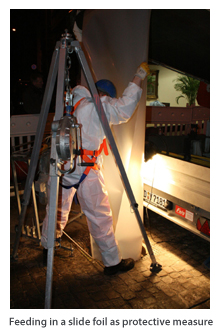 Rehabilitation Task and Tight Timing: The concrete project planning was triggered, however, by a rehabilitation project on the street surface. As the tram rail track of the Ostertorsteinweg was up for renewal, the opportunity was utilized to also fix the underground. The track renewal provided not only the occasion for rehabilitation, but also the timing of the sewer rehabilitation, which should take place in three construction sections, according to the planning of HanseWasser. While the second and third construction section between Poststraße, Mozartstraße and Goetheplatz at the beginning of April 2008 should be realized at a point in time when then tram traffic had already been suspended, the construction section one between Bauernstraße and Poststraße was set for roughly one month earlier and had to be coordinated with the running tram (ÖPNV) operation. This resulted in an extremely tight time schedule – in particular for the first construction section. To impede the rail traffic as little as possible, the maximum time frame was open from Friday, 7 March, 9 p.m. (last tram) to Monday, 10 March 3 a.m. (first tram). In this corridor two liners of 32.50 m and 173.60-m length had to be installed, including all preparatory and related work.
Rehabilitation Task and Tight Timing: The concrete project planning was triggered, however, by a rehabilitation project on the street surface. As the tram rail track of the Ostertorsteinweg was up for renewal, the opportunity was utilized to also fix the underground. The track renewal provided not only the occasion for rehabilitation, but also the timing of the sewer rehabilitation, which should take place in three construction sections, according to the planning of HanseWasser. While the second and third construction section between Poststraße, Mozartstraße and Goetheplatz at the beginning of April 2008 should be realized at a point in time when then tram traffic had already been suspended, the construction section one between Bauernstraße and Poststraße was set for roughly one month earlier and had to be coordinated with the running tram (ÖPNV) operation. This resulted in an extremely tight time schedule – in particular for the first construction section. To impede the rail traffic as little as possible, the maximum time frame was open from Friday, 7 March, 9 p.m. (last tram) to Monday, 10 March 3 a.m. (first tram). In this corridor two liners of 32.50 m and 173.60-m length had to be installed, including all preparatory and related work.
Light-Curing GFRP Liner: The related work included the opening of the connection lines that are covered up by the liner. This work played a decisive role in the selection of the process due to the time factor. The planners at HanseWasser decided at the outset that only light-curing GFRP liner systems were to be considered: With this pipe lining variant there is no need to consider the reduction of stresses in the liner, which can take several days. The lack of shrinkage means that there are no axial movements and the connections can be milled out directly after the curing of the liner without the danger of changes in the length. Considering the high density of connections in Ostertorsteinweg and the fact that behind almost every connection there is a multi-story residential building with retail space in the ground floor, smooth maintenance of the drainage was especially important. Using the example of the 173-m liner, the longest of the entire project, the extremely quick execution of the construction project with the Brandenburger liner system can be clearly illustrated.
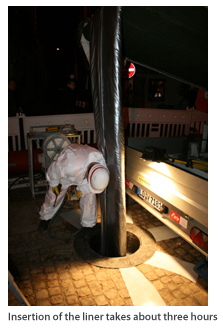 In order to maintain the drainage during the rehabilitation, DN 400 free-flow pipelines were installed aboveground as water drainage including sufficiently powerful pumps. On 7 March, at exactly 9 p.m., the last train had just disappeared around the corner and the preparatory cleaning work began in the collection drain so that at 11 p.m.,the Brandenburger construction crew could begin with the insertion of the liner through the start shaft near Poststraße. The 10.4-ton glass fiber tube was let down into the opened shaft, out of the transport packaging and using an electrical conveyor belt and pulled with a steel cable connection to the target shaft at the Weberstraße. A foil that had been laid down protected it from damages due to rubbing on the base of the pipe. At 2 a.m. on Saturday morning, the liner lay in the Ostertorsteinweg collection drain in its entire length. At the start and end shaft it was equipped with pressure locks so that it could then be expanded in the sewer using compressed air (Fig. 3-5).
In order to maintain the drainage during the rehabilitation, DN 400 free-flow pipelines were installed aboveground as water drainage including sufficiently powerful pumps. On 7 March, at exactly 9 p.m., the last train had just disappeared around the corner and the preparatory cleaning work began in the collection drain so that at 11 p.m.,the Brandenburger construction crew could begin with the insertion of the liner through the start shaft near Poststraße. The 10.4-ton glass fiber tube was let down into the opened shaft, out of the transport packaging and using an electrical conveyor belt and pulled with a steel cable connection to the target shaft at the Weberstraße. A foil that had been laid down protected it from damages due to rubbing on the base of the pipe. At 2 a.m. on Saturday morning, the liner lay in the Ostertorsteinweg collection drain in its entire length. At the start and end shaft it was equipped with pressure locks so that it could then be expanded in the sewer using compressed air (Fig. 3-5).
Lamp Train and Curing: In the decisive, subsequent process step, a lamp train with nine UV modules with each 1,000-watt maximum power was pulled through the form-fit calibrated liner with precisely pre-calculated speed (Fig. 6). The connection to the new UV technology with special resin recipe made it possible to also achieve curing in a very short time here. The light-curing process lasted a total of four and a half hours at a train speed of 65 cm per minute and was recorded in all relevant parameters (for instance, speed, exposure dose and liner temperature). The computer-aided documentation of these data allowed for any eventual deviations from target values of the technical parameters to be recognized immediately and allowed meticulous tracking of the curing procedure, a cornerstone of the quality management (Fig. 7+8).
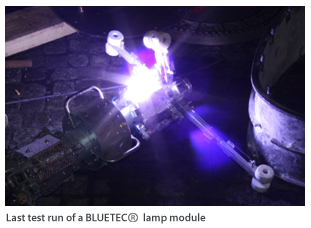 Connection Lines: Directly after the curing of the liner, work was started to open the connections. On Saturday, 8 March at 12 p.m., all 48 residential connections in the rehabilitated collection drain were milled open again and promptly at the start of the tram traffic on Monday morning at 9 a.m. they were all connected again, according to the specifications of the client: This was accomplished with the installation of glass fiber short liners up to 50 cm over the first pipe connection in the connection. The direct support area was filled with an epoxy resin system to be waterproof and have no cavities. The local residents were hardly affected by the project with respect to disagreeable effects of construction projects, which were considerably more moderate than the subsequent renewal of the tramline tracks and the roadway made of granite cobblestone.
Connection Lines: Directly after the curing of the liner, work was started to open the connections. On Saturday, 8 March at 12 p.m., all 48 residential connections in the rehabilitated collection drain were milled open again and promptly at the start of the tram traffic on Monday morning at 9 a.m. they were all connected again, according to the specifications of the client: This was accomplished with the installation of glass fiber short liners up to 50 cm over the first pipe connection in the connection. The direct support area was filled with an epoxy resin system to be waterproof and have no cavities. The local residents were hardly affected by the project with respect to disagreeable effects of construction projects, which were considerably more moderate than the subsequent renewal of the tramline tracks and the roadway made of granite cobblestone.
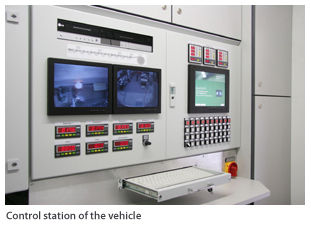 Further Construction Sections: The combined second and third construction section in Ostertorsteinweg were performed between 4 and 14 April 2008. As the tram traffic was already suspended, there was not the same level of time pressure here as in the first construction section. Nonetheless, within these six days two 115- and 128-m long liners were installed with all preparatory and related work. The pause of almost four weeks after the first construction section occurred because a large number of residential connections, in the area of the collection drain that was still to be rehabilitated, were renewed in open cut, which entailed excavation work but also the renewed preparation of the surrounding drainage conduit. The independent laboratory inspection as a major component of the quality management system was performed in the Ostertorsteinweg project by the APS testing-institute-certified engineering company Siebert in Oststeinbek. Their analysis of the liner samples taken from the construction site came to the positive result that all specified parameter nominal values of all liners were exceeded by at least 10 percent.
Further Construction Sections: The combined second and third construction section in Ostertorsteinweg were performed between 4 and 14 April 2008. As the tram traffic was already suspended, there was not the same level of time pressure here as in the first construction section. Nonetheless, within these six days two 115- and 128-m long liners were installed with all preparatory and related work. The pause of almost four weeks after the first construction section occurred because a large number of residential connections, in the area of the collection drain that was still to be rehabilitated, were renewed in open cut, which entailed excavation work but also the renewed preparation of the surrounding drainage conduit. The independent laboratory inspection as a major component of the quality management system was performed in the Ostertorsteinweg project by the APS testing-institute-certified engineering company Siebert in Oststeinbek. Their analysis of the liner samples taken from the construction site came to the positive result that all specified parameter nominal values of all liners were exceeded by at least 10 percent.
Conclusion: As a result of the analysis results, HanseWasser was extremely pleased with the successful and on schedule completion of the rehabilitation project. The successful Ostertorsteinweg rehabilitation project accentuated not only the special advantages of the liner process that was used, but is also another example for the plus factors of the trenchless pipe lining technology as a whole (Fig. 9).
Christina Mueller is a marketing and management assistant with Brandenburger Liner GmbH & Co. KG, which is based in Landau, Germany. For more information, visit www.brandenburger.de


